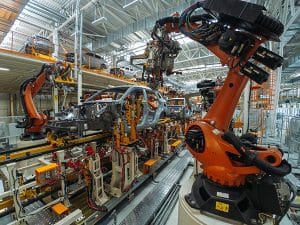
Chris Kuehl
Managing Director • Armada
The dominant story in the vehicle sector at the moment is the UAW strike and as one would expect the situation changes by the hour. The strike that has been called affects Ford, General Motors and Stellantis (Chrysler/Jeep/etc.). This is the first time the UAW has struck all three at the same time and the tactics used are very different than in the past. Negotiations have traditionally been behind closed doors but both the union and the companies have been fighting this battle in public with intense media usage. The issues are complex – everything from very steep wage demands, pension demands and issues of job security. The biggest concern for the UAW has been the potential loss of jobs as manufacturing continues to move to Mexico. The wage and hours conversation is actually less important than security. Ford has already made concessions and GM is likely to be next but Stellantis is another story. This is a company with far more presence in Europe and has alternative production options. Their CEO is Carlos Tavares and he has experience with tough unions in Europe which have more power than does the UAW. The estimates of how long this strike will last are varied.
There are three sets of economic implications to consider as an NAED member. The first and most obvious is the impact on the auto industry itself. These shutdowns are costing each of the car companies a billion dollars in just ten days. The second impact is perhaps more important as this is the impact on the thousands of suppliers that feed into these assembly operations. These are often smaller operations and are scattered all over the country. Thei margins are narrow to begin with and even short disruptions can be crushing. The third economic impact is felt in the communities where these companies operate. The workers will see their income drop drastically as long as they are on strike and that will affect every aspect of consumer activity. Many projects will be delayed that have no direct connection to the automotive sector.
The expectation is that assemblies will continue to build by at least 7.0% in 2023 despite the impact of the strike as more of the impact will be felt in 2024. This is a different kind of supply chain threat. It is not the lack of parts from overseas suppliers as it will be the lack of parts from domestic producers affected by the strike. The automakers had planned to start bringing more variety back to their model offerings but that may now be inhibited. The majority of the design work still has a focus on fuel efficiency and electronics. There are many government incentives designed to accelerate the shift towards electric vehicles but the percentage of electrics in the total US fleet remains very low – less than 7% of the average 15.6 million total units sold in the US annually. The greatest inhibition is still infrastructure. Consumers will not purchase an electric vehicle if they are worried about access to charging stations. Development of that infrastructure is dependent on the creation of sufficient demand. Advocates assert that incentives will drive demand but experience has shown that fuel prices are still the primary trigger. As the price of gasoline rises there is more desire to switch and right now the per gallon price is higher than it has been in over a year ($3.85 nationally). There is also the issue of financing. The average price of a vehicle is now $47,000 and with banks tightening their loan standards there will be fewer eligible buyers. The other factors that determine demand are still positive – low levels of unemployment and generally strong savings. This latter factor has been shifting fast, however. Credit card debt in the US is now at $7 trillion and overall consumer debt is at $70 trillion. Roughly a third of the consumer population is now living paycheck to paycheck.
The supply chain crisis of 2020 forced a massive adjustment in the Just-in-Time (JIT) system (some assert it has become the “eventually-maybe” system) and of global supply chains. The U.S. saw over a trillion dollars of reshoring in 2022 and is on track for three times this number in 2023. Over half of this activity is related to the vehicle sector. . Mexico has never seen higher levels of foreign direct investment and much of this has been for new projects. The growth data for Mexico has shown major gains in manufacturing as there will be over $13 billion in investment from companies reducing their exposure to long supply chains. Fully 40% of the assembly activity in Mexico involves U.S.- made parts. The bulk of this expansion will be in industrial cities such as Queretaro, San Luis Potosi, Saltillo, and Monterrey. In the wake of the UAW strike announcement there were five new investments in automotive manufacturing in Mexico where wages are a fraction of those offered in the US.
Much of the anticipated growth is now in question due to the UAW strike. Sales were still trending higher in 2023 over 2022 as automakers caught up with demand. There was an expectation of 5% growth over 2022. The issue is not demand, that remains strong. Now the issue is supply and that is reminiscent of the pandemic crisis. The default rate for car loans is now at 3.89% and it is still climbing. The long-term average for default is 3.46%. Automakers are still relying on the top sellers as they account for 80% of production. The most popular models continue to be SUVs, CUVs, and trucks but these are the very vehicles that are the most sensitive to fuel prices. If there is a continued surge in the price at the pump the appeal of electric cars and fuel sippers will increase. An extended strike will cost over a point of GDP growth. Sales for those companies not affected by the strike are expected to boom. Those vehicles made by companies not affected by the strike will likely see greater demand. The Big Three in the US are still Ford, GM and Chrysler (Stellantis) but they are not the world’s Big Three. That honor goes to Volkswagen, Toyota and Stellantis (by virtue of including Fiat).
The number one motivation for a consumer remains employment status and job stability. The unemployment rate is still extremely low (3.8%) and the data from the JOLTS report shows that quits are as high as they have been in decades. This is a very reliable indicator of employment confidence. People have the ability to go into debt to buy a car. The second motivation is the age of the vehicle; the average age now is 12.5 years. In past years people decided to replace cars when they reached four or five years and 50,000 miles. Now it is not unusual to own a car with 150,000 miles or more. Prices remain high, the average is still above $48,000. This has priced many out of the market and pushed people toward the used market (driving those prices up as well). These are the underlying factors that drive the auto sector. The bottom line is the industry needs consumers that have a desire to buy and can afford to buy. If either of these factors is missing the industry slumps. There are very wide differences between generations and that concerns the industry as well. Boomers were the car buyers and Gen-Z is much less interested.
Recent Posts
- Economic Reconnaissance | Economic Growth During the Next Presidency December 3, 2024
- How Credit Managers Can Step into Executive Leadership November 13, 2024
- Economic Reconnaissance | Putting the FAB in Fabrinomics!! October 1, 2024
- Economic Reconnaissance | Sifting Through the Noise During “Silly Season” August 1, 2024
- A Big Win for Creditors of Small Business Debtors June 27, 2024
- Economic Reconnaissance | The Fable of Henny Penny June 4, 2024










